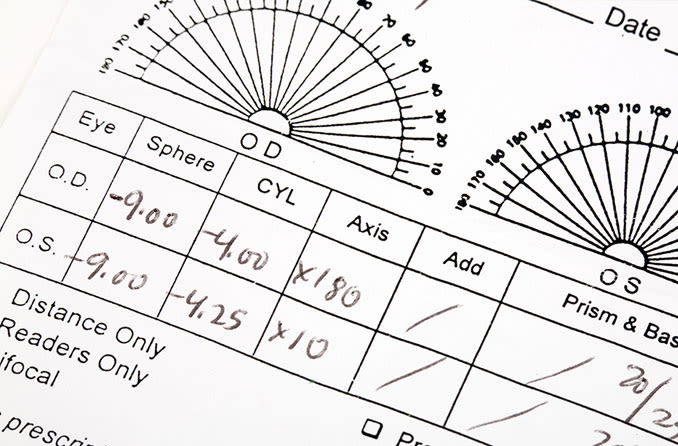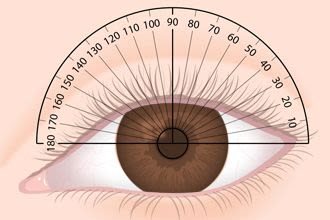If you’re confused about what the words and numbers on your prescription mean, ask your eye healthcare provider to explain them to you.
How to read your eyeglasses prescription

The numbers on your eyeglass prescription relate to the shape of your eyes and strength of your vision. They can help you figure out whether you have nearsightedness, farsightedness or astigmatism — and to what degree.
If you know what to look for, you can make sense of the numbers and abbreviations on your prescription chart.
OD vs. OS: One for each eye
Eye doctors use the abbreviations “OD” and “OS” to denote your right and left eyes.
Your eye doctor may give you a paper prescription that looks something like this.
- OD is your right eye. OD is short for oculus dexter, the Latin phrase for “right eye.”
- OS is your left eye. OS is short for oculus sinister, Latin for “left eye.”
Your vision prescription may also have a column labeled “OU.” This is the abbreviation for oculus uterque, which means “both eyes” in Latin.
These abbreviated terms are common on prescriptions for glasses, contact lenses and eye medicines, but some doctors and clinics have opted to modernize their eye prescriptions by using RE (right eye) and LE (left eye) instead of OD and OS.
The information for your right eye (OD) always comes before the information for your left eye (OS). Eye doctors write prescriptions this way because, when they face you, they see your right eye on their left (first) and your left eye on their right (second).
Sphere (SPH)
Sphere indicates the amount of lens power prescribed to correct nearsightedness or farsightedness. Lens power is measured in diopters (D).
- If the number under this heading comes with a minus sign (–), you are nearsighted.
- If the number under this heading has a plus sign (+), you are farsighted.
The term “sphere” means that the correction for nearsightedness or farsightedness is “spherical,” or equal in all meridians of the eye.
Cylinder (CYL)
Cylinder indicates the amount of lens power needed for astigmatism. It always follows the sphere power on an eyeglass prescription.
The number in the cylinder column may have a minus sign (for correction of nearsighted astigmatism) or a plus sign (for farsighted astigmatism).
If nothing appears in this column, you either don’t have astigmatism, or your degree of astigmatism is so small that it doesn’t need to be corrected.
The term “cylinder” means that this lens power added to correct astigmatism is not spherical, but instead is shaped so one meridian has no added curvature, and the meridian perpendicular to this “no added power” meridian contains the maximum power and lens curvature to correct astigmatism.
Meridians of the eye are determined by superimposing a protractor scale on the eye’s front surface. The 90-degree meridian is the vertical meridian of the eye, and the 180-degree meridian is the horizontal meridian.

Meridians of the eye are determined by superimposing a protractor scale on the eye’s front surface. The 90-degree meridian is the vertical meridian of the eye, and the 180-degree meridian is the horizontal meridian.
Axis
Axis describes the lens meridian that contains no cylinder power to correct astigmatism.
If an eyeglass prescription includes cylinder power, it also needs to include an axis value, which follows the cylinder power.
The axis is defined with a number from 1 to 180.
- The number 90 corresponds to the vertical meridian of the eye.
- The number 180 corresponds to the horizontal meridian of the eye.
The axis is the lens meridian that is 90 degrees away from the meridian that contains the cylinder power for astigmatism correction.
Add
“Add” is the added magnifying power applied to the bottom part of multifocal lenses to correct presbyopia — the natural farsightedness that happens with age.
The number appearing in this section of the prescription is always a “plus” power, even when you don’t see a plus sign. Generally, it will range from +0.75 to +3.00 D and will be the same power for both eyes.
Prism
This is the amount of prismatic power, measured in prism diopters (“p.d.” or a triangle when written freehand), prescribed to compensate for eye alignment problems.
Only a small percentage of eyeglass prescriptions include a prism measurement.
When present, the amount of prism is indicated in either metric or fractional English units (0.5 or ½, for example), and the direction of the prism is indicated by noting the relative position of its “base” (thickest edge).
Four abbreviations are used for prism direction: BU = base up; BD = base down; BI = base in (toward the wearer’s nose); BO = base out (toward the wearer’s ear).
How they’re measured
Sphere power, cylinder power and add power always appear in diopters. They are in decimal form and generally are written in quarter-diopter (0.25 D) increments.
Axis values are whole numbers from 1 to 180 and signify only a meridional location, not a power.
When prism diopters are indicated in decimal form, typically only one digit appears after the period (e.g., 0.5).
An example eye prescription chart
Still confused? Let’s look at an example prescription chart:
| SPH | CYL | Axis | Add | Prism | |
|---|---|---|---|---|---|
| OD | -2.00 | SPH | +2.00 | 0.5 BD | |
| OS | -1.00 | -0.50 | 180 | +2.00 | 0.5 BU |
In the right eye (OD), the eye doctor prescribed:
- -2.00 D sphere for the correction of nearsightedness.
- No cylinder power or axis, which means no astigmatism is present. This doctor chose to write “SPH,” to confirm the right eye is being prescribed only spherical power. Some doctors will add “DS” for “diopters sphere” and others will leave it blank.
The left eye (OS) was prescribed:
- -1.00 D sphere for nearsightedness correction.
- -0.50 D cylinder for the correction of astigmatism.
- A cylinder power with an axis at the 180 meridian. This means that the horizontal (180-degree) meridian of the eye has no added power for astigmatism and the vertical (90-degree) meridian gets the added -0.50 D from the cylinder column.
Both eyes were prescribed:
- An “add power” of +2.00 D for the correction of presbyopia.
- Prismatic correction of 0.5 prism diopter in each eye. In the right eye, the prism is base down (BD); in the left eye, it’s base up (BU).
Your eye doctor may also write specific lens recommendations on your eyeglass prescription. They might suggest anti-reflective coating, photochromic lenses and/or progressive lenses to give you the most comfortable vision correction possible.
Can eyeglass prescriptions be used to buy contact lenses?
No, you cannot use your glasses prescription to buy contact lenses.
An eyeglass prescription only works for the purchase of eyeglasses. It does not contain certain information that is crucial to a contact lens prescription.
That information can only be obtained through a contact lens fitting, an additional procedure that can be performed during your eye doctor visit.

Eyeglass lenses are positioned at a distance from the eyes, while contacts rest directly on the eyes. That distance affects the lens power required for eyes to focus properly.
In addition to the information in an eyeglass prescription, a contact lens prescription must specify the base (central) curve of the back surface of the contact lens, the lens diameter, and the specific manufacturer and brand name of the lens.
Also, the power of an eyeglass prescription frequently is modified when determining the best contact lens power. This is because eyeglass lenses are worn some distance (usually about 12 millimeters) from the surface of the eye, whereas contact lenses rest directly on the cornea of the eye.
An accurate contact lens prescription can be written only after a contact lens fitting has been performed and the prescribing doctor has evaluated your eyes’ response to the lenses and to contact lens wear in general.
Your eyeglass prescription is yours to keep
The Federal Trade Commission (FTC) is the U.S. government’s consumer protection agency. Their Prescription Release Rule requires that eye doctors give patients a copy of their eyeglass prescription at the end of an eye exam that includes a refraction.
The Prescription Release Rule is intended to allow the “portability” of your eyeglass prescription, giving you the freedom to buy glasses from any vendor of your choice.
Your eye doctor must give you a copy of the prescription whether or not you ask for it. Eye doctors may not condition the release of your prescription on your agreement to purchase eyeglasses from them, nor may they charge you an extra fee to release your prescription.
If you think your eye doctor has violated this rule, you can report the problem to the FTC.
Page published on Wednesday, February 27, 2019
How to Read an Eyeglass Prescription
Troy L. Bedinghaus, OD, board-certified optometric physician, owns Lakewood Family Eye Care in Florida. He is an active member of the American Optometric Association.
Johnstone M. Kim, MD, is a board-certified ophthalmologist and a practicing physician at Midwest Retina in Dublin, Ohio.
Table of Contents
Table of Contents
If you need eyeglasses, you might be confused by the numbers, terms, and symbols on your prescription. However, there are important reasons why it’s written the way it is.
Eyeglasses prescriptions use the same standard format and common notations. This makes them universal, meaning that they can be read anywhere in the world.
The article will use a sample eyeglasses prescription to walk you through how to read your own.
:max_bytes(150000):strip_icc()/eyeglass-prescriptions-3421911-ADD-FINAL-26235ff7e7944a3cb3e4ff7cf933c8b5.png)
Latin Abbreviations
Providers who write eyeglasses prescriptions may Latin abbreviations. While they have been used for a long time, Latin abbreviations are becoming less common.
On your prescription, you might see abbreviations for specific terms instead.
For example, the word “power” is sometimes written as “PWR.” Another common term is “sphere” which is sometimes abbreviated as “SPH” on a prescription.
Example Prescription
OD: -2.00 – 0.50 x 180
OS: +1.00 DS
ADD: +1.75 OU
Here’s what the Latin abbreviations on the example prescription mean:
- OD stands for “oculus dexter” and refers to the right eye.
- OS stands for “oculus sinister” and refers to the left eye.
- OU stands for “oculi uterque” and refers to both eyes.
What Do The Numbers Mean?
In addition to terms and abbreviations, eyeglasses prescriptions also include a lot of numbers.
You’ll also see some mathematical symbols like the plus sign (+) and minus sign (-).
Sphere
In the example prescription, the first number to the right of OD is -2.00. This is the “sphere” part of the prescription, which may be abbreviated as “SPH.”
The sphere number indicates whether you have nearsightedness or farsightedness.
Nearsighted people have trouble seeing things that are far away. Farsighted people have trouble seeing things that are up close.
You’ll also see a plus sign or minus sign before the number.
- A minus sign (-) means you need a negative-powered lens. These lenses are used to correct nearsightedness.
- A positive sign (+) means you need a positive-powered lens. These lenses correct farsightedness.
Cylinder
The next number in the sample prescription is -0.50. This is the “cylinder” measurement. On your prescription, “cylinder” might be abbreviated as “CYL.”
The cylinder measures the degree of astigmatism in your eye. The number shows how much lens power will be needed to correct astigmatism.
Axis
The next number is x 180, which is read as “axis 180.” On your prescription, “axis” is sometimes abbreviated as “X” or “AX.”
This number is an angle in degrees from 0 to 180. If you have astigmatism, this number points to where it is in your eye.
The cornea is the clear covering of your eye. It is the part of your eye that does most of the focusing.
Placeholders
It is common to write SPHERE or DS as a placeholder where the astigmatism number goes.
This helps make sure that the reader knows the provider did not forget to record the cylinder or astigmatism correction.
In the example, the left eye’s “sphere” number is plus one (+1.00) DS.
The letters DS mean “diopters sphere.” This number means the left eye’s correction is spherical with no astigmatism.
In other words, the right cornea probably has a slightly oblong shape while the left cornea is very close to being perfectly round.
ADD Number
In the example, the ADD number of +1.75 notes how much power needs to be “added” to the distance prescription. This addition helps a person see better for reading and other activities that they do up close.
Younger people’s prescriptions usually do not have an ADD number. While some young people can have near-focusing problems, it usually develops as you approach 40.
ADD vs. Powers for Readers
Some people think the ADD number is the power needed for over-the-counter (OTC) reading glasses (or “readers”), but it’s not the same thing.
To get the right number, you need to do a little math.
To find the right reading glasses, add the sphere number to the ADD number.
In the above example, for the right eye, this would be -2.00 and +1.75, which equals -0.25. For the left eye, add +1.00 and +1.75 to get +2.75.
Next, look at the cylinder measurement and the axis measurement.
In the example, the correct number for the right eye is -0.25 -0.50 x 180 while the correct number for the left eye is simply +2.75.
The example was chosen to show the difference between nearsighted and farsighted prescriptions. For most people, the numbers are usually similar in power for both eyes.
Other Abbreviations
You may also see a few other words or abbreviations on your eyeglasses prescription:
- SVD: This means you only need glasses for single vision distance (for distance vision correction only)
- SVN: This means you only need glasses for single vision near (for reading glasses only)
- PD (pupillary distance): This is how much space there is between the centers of the two pupils of your eyes. This measurement is how your provider makes sure that your glasses are comfortable to wear and optically perfect.
- Prism: This measurement usually only applies to people with crossed eyes (strabismus) or other eye muscle or focusing disorders. In glasses with this measurement, the image in the lens is displaced in a certain direction.
Summary
Your eyeglasses prescription may include Latin abbreviations, numbers, and mathematical signs. These numbers are used to describe the shape of your eye and the correction you need in your glasses.
- OD and OS refer to the right and left eye.
- SPH shows if you have nearsightedness or farsightedness.
- CYL and AX/X numbers note if you have astigmatism .
- ADD indicates the amount of correction that will need to be “added” to your prescription for reading.
- PD is the distance between your pupils; this number ensures that your glasses are the right fit for your face.
If you’re confused about what the words and numbers on your prescription mean, ask your eye healthcare provider to explain them to you.
Verywell Health uses only high-quality sources, including peer-reviewed studies, to support the facts within our articles. Read our editorial process to learn more about how we fact-check and keep our content accurate, reliable, and trustworthy.
- Vimont C, Turburt C. What do astigmatism measurements mean? American Academy of Ophthalmology. Published April 5, 2021.
- MedlinePlus. Presbyopia.
- Porter D. What is prism correction in eyeglasses? American Academy of Ophthalmology.
Additional Reading
- Polasky M. Monocular Subjective Refraction. In: Clinical Procedures in Optometry. Lippincott; 1991:174-188.
By Troy Bedinghaus, OD
Troy L. Bedinghaus, OD, board-certified optometric physician, owns Lakewood Family Eye Care in Florida. He is an active member of the American Optometric Association.
Share Feedback
Was this page helpful?
Thanks for your feedback!
What is your feedback?
Other Helpful Report an Error
Related Articles
:max_bytes(150000):strip_icc()/GettyImages-1413552660-62b3605491c644abaa39bcbee64efa64.jpg)
Squinting Eyes
:max_bytes(150000):strip_icc()/african-american-woman-reading-book-103925061-5790db7e3df78c09e93b64ed.jpg)
How to Buy Reading Glasses
:max_bytes(150000):strip_icc()/GettyImages-578083754-d7f5f649d308476f95b71e9487fdb721.jpg)
What Is Pseudophakia?
:max_bytes(150000):strip_icc()/GettyImages-1343839357-343a85f7d91e40428830f948e2c6f51b.jpg)
Astigmatism Laser Surgery: Overview
:max_bytes(150000):strip_icc()/135351113-56a9cfc73df78cf772aab59a.jpg)
How to Find Your Dominant Eye
:max_bytes(150000):strip_icc()/GettyImages-571644845-56d7b5cf3df78cfb37dbe562.jpg)
What Is Nearsightedness?
:max_bytes(150000):strip_icc()/GettyImages-1257791112-f7dcb65ffbe94f5aba4648589014ea8a.jpg)
Astigmatism vs. Keratoconus: What Are the Differences?
:max_bytes(150000):strip_icc()/GettyImages-946305934-6259aa3896a04e6e87b79508845db04f.jpg)
What Is Presbyopia?
:max_bytes(150000):strip_icc()/GettyImages-88160303-a91641e088804c18a98d345e11af6958.jpg)
Understanding Prescription Abbreviations
:max_bytes(150000):strip_icc()/laser-eye-surgery-1178747545-b42499ff1f9f4076ade6614145b177c4.jpg)
Purpose of LASIK Eye Surgery
:max_bytes(150000):strip_icc()/GettyImages-1273514122-6277dbb9b8794f758f728594f7c2ed1d.jpg)
PRK vs. LASIK: Uses, Benefits, Side Effects and More
:max_bytes(150000):strip_icc()/GettyImages-491541644-f6f2e30d878446e5a3666a3c069e969c.jpg)
Testing for Astigmatism
:max_bytes(150000):strip_icc()/esotropia584188178-5a47bd82beba330037d008c3.jpg)
What Is Esotropia?
:max_bytes(150000):strip_icc()/GettyImages-1370906493-ab6bf1b6d89c4d01a758db43c3a9e845.jpg)
The FDA Approved the First Online Vision Test. What Can It Do?
:max_bytes(150000):strip_icc()/GettyImages-sb10068911c-001-56acd9d83df78cf772b653c9.jpg)
8 Reasons Lasik Eye Surgery Might Not Be Right for You
:max_bytes(150000):strip_icc()/GettyImages-1096524578-2262b44557ec4c4caaa1df565430d177.jpg)
Lens Replacement Surgery vs. LASIK: Uses, Benefits, Side Effects and More
- Meet Our Medical Expert Board
- About Us
- Editorial Process
- Diversity Pledge
- Privacy Policy
- In the News
- Advertise
- Terms of Use
- Careers
- Contact
- EU Privacy
Verywell Fit
Verywell Mind
Verywell Family
Verywell Health’s content is for informational and educational purposes only. Our website is not intended to be a substitute for professional medical advice, diagnosis, or treatment.
Ⓒ 2023 Dotdash Media, Inc. — All rights reserved
When you visit the site, Dotdash Meredith and its partners may store or retrieve information on your browser, mostly in the form of cookies. Cookies collect information about your preferences and your devices and are used to make the site work as you expect it to, to understand how you interact with the site, and to show advertisements that are targeted to your interests. You can find out more about our use, change your default settings, and withdraw your consent at any time with effect for the future by visiting Cookies Settings, which can also be found in the footer of the site.






